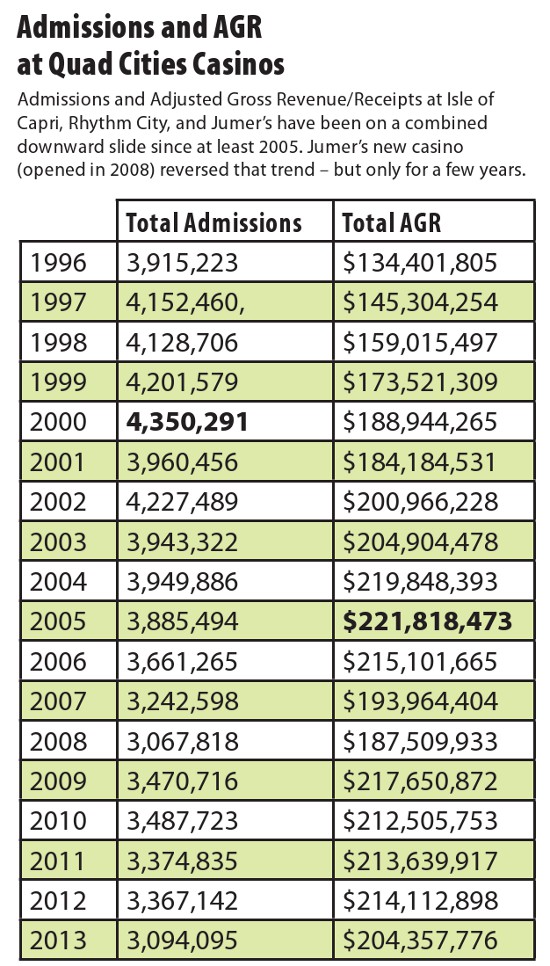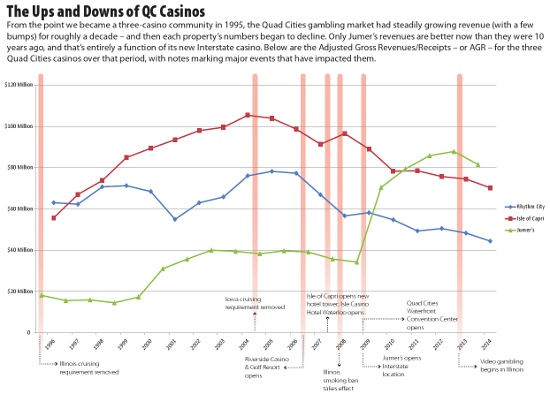 It's long been an article of faith with me that the seemingly perpetual growth in the number of state-sponsored gambling outlets is poor public policy. Common sense says that the amount of money people will spend on these games has a ceiling - one that we've almost certainly reached by now.
It's long been an article of faith with me that the seemingly perpetual growth in the number of state-sponsored gambling outlets is poor public policy. Common sense says that the amount of money people will spend on these games has a ceiling - one that we've almost certainly reached by now.
If that's correct, then further expansion of legalized gambling is a fool's errand, as the money generated by it won't increase meaningfully. Once gambling has reached a saturation point in a region, revenues will just get shifted from gaming company to gaming company and state to state and local government to local government.
But like all articles of faith, I had no proof for my hypothesis. So I decided to test it, and the Quad Cities market seemed like an excellent laboratory.
What is now the Isle of Capri casino in Bettendorf opened in April 1995 - making us a three-casino community. (I'll refer to the casinos by their present names throughout this article.) We now have almost two decades of gaming information with the three-casino marketplace, and a handful of variables allow us to see what happened here when this happened there: the December 2008 move of Jumer's from downtown Rock Island to Interstate 280; the recession that hit in 2007-8; new casino competitors in eastern Iowa in 2006 and 2007; and the 2012 introduction of video-gambling machines in Illinois outside of casinos.
What I found didn't exactly support my hypothesis of a Quad Cities gambling pie with a fixed size. Rather, the data suggest there are ways to add new customers to the local gambling market - but that the pie has nonetheless been shrinking for a decade.
The health of our casinos is a matter of public concern. The Quad Cities' gambling outlets are major employers and tourist attractions. They pay property and gambling taxes - revenue that state and local governments rely on. If the casinos continue their long-term slide in the face of more gambling competition, it's not just casino companies whose revenues will fall.
In the next few years, however, you can expect some growth in the local casino business. The move of Davenport's casino from the riverfront to an Interstate 80 location and the Isle of Capri's plan to build a land-based casino to replace its current boat will almost certainly boost their owners' and their communities' revenues.
But history says the gains won't last.
"Everyone is hoping that it [the local gambling market] is going to expand, but ... if you take a look at what's been happening, that's not the direction that it's going," said Bill Renk, the director of public relations and promotion for Jumer's Casino & Hotel. "So there'll be a shift and redistribution of market shares, but it will be a challenge to grow the market ... in light of what's happening."
The Big Numbers
For the 18 most recent full years (1996 through 2013), admissions at Quad Cities casinos totaled more than 67 million - or more than 3.7 million visits per year. (Iowa tabulates its attendance and revenue totals on a July-to-June fiscal-year basis, while Illinois works with calendar years.)
For the same period, the net amount of money casinos took in totaled $3.49 billion, or almost $194 million per year. This figure is called Adjusted Gross Revenue in Iowa and Adjusted Gross Receipts in Illinois, but they're fundamentally the same thing; for simplicity, we'll call it AGR. Gamblers collectively win back a little more than 90 percent of their wagers at our casinos, and the remainder is AGR.
But AGR is not the casino companies' profit; they have employees and other costs. Renk defined AGR as "the casino win ... before we pay any bills." (I called Renk to ensure I wasn't misreading the numbers, but also because Jumer's is responsible for the largest change in the local market - and is most directly affected by legalized video gambling in Illinois.)
One significant cost for casinos is gambling taxes - the primary reason local residents should be concerned about the current downward trend. And over these 18 years, the total to local governments in the Quad Cities has been more than $82.5 million from casinos. State governments have received more than $648 million. That's $731 million - more than $40 million a year - that gamblers in the Quad Cities have forked over in taxes. Almost 21 percent of AGR has gone to government.
State Against State
With two casinos on the Iowa side of the Mississippi and one on the Illinois side, those figures aren't distributed evenly. Each state has its own formula for divvying up gambling revenue, further skewing distributions.
From 1996 to 2013, Rhythm City and Isle of Capri had combined admissions of 51.8 million, while Jumer's had admissions of 15.7 million. Iowa casinos therefore accounted for 76.7 percent of admissions.
In a similar breakdown, Rhythm City and Isle of Capri had combined AGR of $2.69 billion during the period, while Jumer's had $802 million - meaning that Iowa casinos got 77.0 percent of AGR.
State-government revenue was $508 million for Iowa and $140 million for Illinois - a 78.4-percent share for Iowa.
But even though our Iowa casinos had more than three-quarters of market share for the period in both admissions and AGR, local government in Illinois has benefited far more. The local-government share of Quad Cities casino revenues was only $26.7 million in Iowa compared to $55.8 million in Illinois - a reversal of market dynamics in which Illinois accounts for two-thirds of gambling taxes to local government.
One Major Change
Looking at admissions and revenues over nearly two decades ignores that our local market changed dramatically when Jumer's moved to Interstate 280. The casino essentially doubled its business with the move, going from 623,000 admissions and $35.8-million AGR in calendar year 2007 to 1.26-million admissions and $70.5-million AGR in calendar year 2009 - the Interstate casino's first full year of operation. Its local market share by both measures went from below 20 percent to roughly 40 percent - meaning that it went from being the area's third-place casino to its top performer.
And here's where my hypothesis of a gambling pie of a fixed size breaks down, because Jumer's in fact brought new business to the local market - at least in the short term. In 2009, our Iowa casinos lost nearly 185,000 admissions compared to the previous year, while Jumer's added more than 587,000. AGR in the Iowa casinos dropped $6.07 million, while Jumer's added $36.2 million. (Again, these figures represent a reporting-period difference of six months; the Iowa numbers include only seven months when the Jumer's interstate casino was in operation.)
Comparing 2008 to 2010 figures, Iowa casino's bled almost 294,000 admissions and more than $20.1-million AGR when the Illinois casino moved, while Jumer's grew by more than 713,000 admissions and $45.1-million AGR. That's not just moving gamblers from one local casino to another.

The Troubling Trend Over Time
Yet Jumer's immediate gains only expanded the gambling market temporarily - and can't hide a long-term trend of decline for local-casino admissions and AGR.
Admissions for the combined three casinos peaked in 2000 at 4.35 million. In 2013, they were 3.09 million - a decline of nearly 29 percent.
AGR for the combined three casinos topped out in 2005 at $222 million - the reporting period for the year after cruising requirements were lifted for Iowa casinos. In 2013, combined AGR was $204 million - a drop of more than 8 percent from 2005. State-government tax revenue also hit its highest point in 2005 at $41.9 million.
Because Illinois' casino distribution is more generous to local government, the combined local taxes from casino-gaming revenue peaked at $6.89 million in 2012, largely because the AGR for Jumer's hit a high of $87.8 million that year.
From 2010 to 2013, our three casinos dropped almost 394,000 admissions and $8.15 million in AGR - despite the relatively new Jumer's casino at a more-attractive location. AGR at Jumer's was actually higher in 2013 compared to 2010 but dropped from 2012 to 2013.
Admissions at Isle of Capri have been on a steady slide since 2000, and at Rhythm City since 2002. AGR has been dropping at Isle of Capri since 2004, and at Rhythm City since 2005. The new Jumer's undoubtedly buoyed the entire market, but the reality is that the pie for casinos is getting smaller. (In that context, communities are wise to secure guaranteed funding and/or additional financial concessions from gambling companies when they have the opportunity, as Davenport and the Riverboat Development Authority did with the city's new casino operator.)
Renk said he's skeptical that the local casinos can rebound to or past their previous primes: "Are you going to re-peak? I don't see it in the foreseeable future."
But there are reasons for optimism, he added: "The market is still healthy enough that we [the three local casinos] can all be here. We've got something to compete for."
Is It the Economy, Stupid?
The most-obvious explanation for the decline in local gambling would seem to be the economy, specifically the Great Recession that started in late 2007. The complicating factor in evaluating that is the new Jumer's casino.
But the market-wide gaming slide pre-dates the official beginning of the recession - and the opening of the new Jumer's - by several years. It's certainly possible that disposable income as measured by how much money people spend on gambling is the proverbial canary in the coal mine, that gambling spending in the Quad Cities was an early sign of economic distress.
But there are other factors to consider, too, such as increased competition from the opening of two eastern-Iowa casinos: the Riverside Casino & Golf Resort in August 2006 and the Isle Casino Hotel Waterloo in June 2007. The timing of those new players in the marketplace aligns more closely than the recession with the decline in admissions and AGR at Quad Cities casinos.
And Renk said the slide also reflects the novelty of casinos wearing off with customers after more than a decade - and the aging of the casinos' customer base.
The real test of the effect of the economy on gambling revenues in the Quad Cities will be whether they rebound significantly and collectively along with improved household finances.
Determining that will require answers to some key questions. Will Davenport's new casino bring gamblers to the community, or will it merely suck up gamblers already spending their money in the Quad Cities? Can the Isle reverse its fortunes with a new land-based casino at its riverfront site? And can Jumer's hold its own against revitalized competitors?
Most importantly, will any short-term gains be sustained beyond the first few years?
Assuming that the economy continues to improve over the next decade, the significance of the recession on casino revenues will become clearer. In 10 years, market-wide stability (or growth) in AGR would indicate that the recession did indeed drag our local gambling outlets down. But a continuation of the present trend would suggest that the economy was less a factor than gambling saturation and fatigue.
The Convenience Factor
If the economy is a question mark in this discussion, the legalization of video gambling outside of casinos is an exclamation point.
Since video-gaming was introduced in Illinois in late 2012, convenient opportunities for gamblers to spend their money have exploded. From July 2013 to June 2014, Rock Island County had 96 video-gambling licensees, generating $6.12 million in net wagers. (That's the money played minus winnings.) From its debut, net wagers in Rock Island County have totaled $7.38 million.
Of that total, the state has gotten $1.84 million and local governments $369,000.
From a revenue standpoint, there are three key differences between video gambling and casinos.
First, because it's spread throughout the county, the local-government funds are more widely dispersed - to 11 local governments.
Second, because it's taxed at a higher rate (25 percent to the state and 5 percent to the local government), video gambling is more lucrative - at least for the state. (Local governments get a smaller share of net wagers than with casinos, but nearly all of them are now getting something rather than nothing, so you won't hear them complain.)
Third, because video gambling happens at bars and restaurants (among other places), the profits from it stay in the local economy rather than going to casino companies.
Video gambling is spreading the wealth, in other words - at the expense of casinos.
But it's essential to understand that the recent losses Quad Cities casinos have experienced cannot be solely blamed on local video gambling. AGR dropped $10 million at area casinos in 2013 alone - far more than the $7-million-plus net wagers on Rock Island County video gambling during an even longer period. And certainly a significant portion of people gambling in bars and restaurants would not have gone to a casino.
Still, Jumer's AGR peaked in 2012, dropped $6 million in 2013, and was nearly 10 percent lower in the first six months of 2014 compared to 2013. Renk said a large portion of that is because of video gambling in the Quad Cities.
He added that one can't only consider the video-gambling revenue in Rock Island County. He noted that Illinois has more than 17,000 video-gambling machines throughout the state: "That's like 17, 18 casinos."
And that means fewer tourists coming to the Quad Cities to gamble, he said - the new competitive reality for our three casinos: "It isn't just the machines that are in play here. It's people not coming in their car, or their not coming on their bus to this market to play because now they're staying home."











